Roman Catholic Church on the island of Ireland
The Roman Catholic Church on the island of Ireland has a long history. Today it is made up of 76.7% of the population, most of it in the Republic of Ireland (86.8% of the population there) and the remainder in Northern Ireland (40.8%) of the United Kingdom .
history
Beginnings
The Roman Catholic Church in Ireland carries out its tradition on St. Patrick back. In Celtic Christianity there was a great monastic tradition in the first millennium . Countless monasteries with different rules of the order, each usually having its own, populated the country. Here there was a great tendency towards mission , which can be explained by the sacrifice of leaving home (see: Wandering monk ). Saints like Columban moved to mainland Europe and founded new monk cells, which made a major contribution to the Christianization of Europe. Characterized by a strict penitential character, the ear confession , which is still in use today, developed here .
The numerous abbots of the monasteries were at the same time quasi- bishops , who considered themselves an auxiliary bishop for the pontifical functions, since they themselves mostly had no episcopal ordination . It was not until the Synod of Rathbreasail in 1111 that dioceses were formed in the present-day sense, most of which were rather small in area. At the same time, the Irish Church lost its importance for the universal Church and only regained it with a new missionary boom in the 19th century. Numerous religious foundations, many of which went to missions, and numerous vocations to priestly and religious life gave the Catholic Church of Ireland again universal ecclesiastical importance.
Under English influence
With the spread of England on the island, the native population fell further behind. The Kilkenny statutes (1367) forbade colonists from England to adopt Irish customs and to marry between Irish and English. The admission of Irish into collegiate chapters or monasteries was prohibited. But this decision had no effect on the normal country clergy. King Henry III had already written to his legal advisor for Ireland in 1217 that the appointment of Irish to a bishopric was not to be admitted, since the Irish bishops repeatedly cause problems. A protest by the Irish clergy led to Pope Honorius III. declared the royal decree 1220 and 1224 inadmissible. In the following years similar measures were taken in the territories of the Irish princes and the chapters and monasteries forbade the admission of English. The relationship between the English and Irish clergy was anything but harmonious. They were only united by their loyalty to the Pope. Over time, however, it also became clear to the Pope that a reconciliation between the two parties was not possible. So Pope Leo X issued a national separation of the pen from St. Patrick in Dublin and awarded it to the Irish. According to the papal decree, the English should no longer be accepted.
While Ireland still had active bishops' suffrage in the 13th century, the elect in the early 14th century required the consent of the King of England. Just a few years later the king appointed completely vacant. The “choice” was just an expression of the Chapter's opinion. The appointments of bishops often looked accordingly. The candidates were more interested in a political career than in running their diocese. Often the bishops also held high political offices. Their influence within their diocese was rather small, as the majority of the patronage was in the hands of the nobility, who appointed the appropriate clergy. The Earl of Kildare owned over forty patronages in five dioceses. Like the bishops, many pastors did not hold residences, but instead allowed themselves to be represented by poorly paid vicars.
Under King Henry VIII , all of Ireland came to England. As in England, there was a struggle for the supremacy in Ireland and, as a result, the secularization of numerous monasteries and ecclesiastical institutions. But unlike in England, the king encountered vehement resistance here. The royal attempts at Reformation produced exactly the opposite and the population, clergy and bishops were more firmly on the side of the Pope than ever.
At the time of Henry VIII, Ireland had 231 Augustinian Canons , 65 Franciscans , 43 Dominicans , 42 Cistercians , 36 Premonstratensians , 26 Augustinians , 25 Carmelites , 22 Hospitallers , 14 Trinitarians , 9 Benedictines and 43 different types of nunnery .
King Edward VI , Heinrich's successor, now tried to suppress the Catholic services. For this purpose, preachers were specially sent in 1548, who were supposed to drive out the belief in the real presence of the Eucharist from the population . At the same time, the new bishops, who were appointed by the king, enforced the Book of Common Prayer .
With the coronation of Queen Mary , the Catholic Church was reinstated in its old rights and received its possessions, such as B. Dublin Cathedral, back. Since most of the bishops had proven themselves to be “supporters of the Pope”, only the canons of the reimbursed collegiate pens were exchanged. At the same time, the Book of Common Prayer was banned and there was a renewal of Catholic religious practice. There was no persecution of the Protestants. Since the reform had been enforced by the government, it had found almost no supporters.
Queen Elizabeth I , who had succeeded her sister to the throne in 1558, again pursued an anti-Catholic attitude. Before long, senior officials in Ireland were being closely monitored. The Book of Common Prayer came into use again, but could only be used in private homes. It was not until 1560 that parliament decided the general and sole use of the Book of Common Prayer and again transferred control of the church to the crown and thus also the appointment of bishops. Violators were fined, imprisoned and killed.
Once again, London reached its limits. Bishops , clergy and people resisted. Only two bishops bowed to the queen. She could not fill bishops' seats because no one in Ireland was willing to do so. If there was a vacancy, the bishops were immediately appointed by the Pope without even telling the Queen.
As early as 1560 Pope Pius V sent a delegation to Ireland, which was not only supposed to visit the local church, but also to send the names of worthy priests to Rome, who could immediately be raised to bishops in the event of a vacancy. Since theological training in Ireland was hardly possible any longer, many candidates for the priesthood left Ireland and studied in Rome , Leuven or France.
Since 1937
From 1937 to 1973 the Church enjoyed a prominent place in the constitution of the Republic of Ireland . After Vatican II there have been various changes in the Church. Normal civilian clothing for priests and religious sisters is now the rule and many monasteries have also been given up in favor of branches that are housed in a residential building. The number of worshipers, priests and religious has decreased for many years. In 2007, 160 priests died and only nine were ordained.
Pope John Paul II visited Ireland in September 1979; it was a Pope's first visit to Ireland.
Following the publication of the Ryan Report in May 2009 on systematic abuse in Catholic schools and homes between 1940 and 1990, the Murphy Report in late November 2009 exposed an abuse scandal by the Roman Catholic Church in Ireland. Cases of sexual abuse have also become known in many other regional Catholic churches . Cardinal Seán Brady , Primate of Ireland and Archbishop of Armagh, publicly asked for forgiveness several times for decades of abuse.
On Christmas Eve 2009, following public pressure and continued criticism, the fourth and fifth Irish bishops, Eamonn Oliver Walsh and Raymond Field , resigned. Diarmuid Martin , Archbishop of Dublin, then demanded in his Christmas Eve sermon that “criminal behavior” must be prosecuted in any case, and that the renewal of the Church must begin with the past being “seriously and brutally” explained. Brendan Comiskey , Donal Brendan Murray, and James Moriarty had resigned from their episcopal offices in the previous weeks .
Main article: Sexual abuse in the Roman Catholic Church # Ireland
From 2005 to 2011/12, the proportion of Irish who described themselves as “religious” fell from 69% to 47%.
In August 2017, Pope Francis endorsed a text from the Irish Bishops' Conference that breaks a centuries-old taboo: “ Illegitimate children ” of clergy should no longer be denied, hidden and deprived of their identity. The text defines “principles of responsibility of priests who have fathered children in ministry”. Like any other father, clergymen must “live up to their personal, moral, legal and economic responsibilities”. In August 2018, Pope Francis visited Ireland.
The diplomatic representative of the Holy See in Ireland is the Apostolic Nuncio Jude Thaddeus Okolo . His predecessor Charles Brown served from 2011 to March 2017.
The Church suffers from a severe shortage of young priests: In 2017, six young men began their training in the Maynooth seminary .
Data
The popular church is divided into four ecclesiastical provinces, with a total of 26 dioceses . They are home to 4,063,000 Catholics, 76.7% of the population. In 2002, 3,160 diocesan and 1,833 religious priests took care of 1,367 parishes , in which 8,678 religious sisters also live.
List of dioceses by ecclesiastical province
The four ecclesiastical provinces are divided into four archdioceses and twenty-two suffragan dioceses .
Ecclesiastical Province of Armagh
| Archdiocese / Diocese | cathedral | Location of the diocese in the ecclesiastical province |
website | |
|---|---|---|---|---|
|
Archbishopric of Armagh Archbishop of Armagh |
St Patrick's Cathedral , Armagh |

|
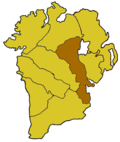
|
www.armagharchdiocese.org |
|
Bishopric of Ardagh Bishop of Ardagh |
St. Mel's Cathedral, Longford |

|
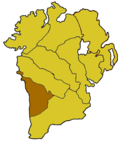
|
www.ardaghdiocese.com |
|
Diocese of Clogher Bishop of Clogher |
St Macartan's Cathedral, Monaghan |

|

|
www.clogherdiocese.ie |
|
Diocese of Derry Bishop of Derry |
St Eugene's Cathedral, Derry |

|

|
www.derrydiocese.org |
|
Diocese of Down and Connor Bishop of Down and Connor |
St. Peter's Cathedral , Belfast |

|

|
www.downandconnor.org |
|
Diocese of Dromore Bishop of Dromore |
Cathedral of Saint Patrick and Saint Colman, Newry |

|
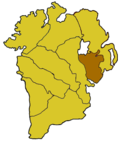
|
www.dromorediocese.org |
|
Bishopric of Kilmore Bishop of Kilmore |
Cathedral of Saint Patrick and Saint Felim, Cavan |

|

|
www.kilmorediocese.ie |
|
Bishopric of Meath Bishop of Meath |
Cathedral of Christ the King, Mullingar |

|

|
www.dioceseofmeath.ie |
|
Diocese of Raphoe Bishop of Raphoe |
Cathedral of St. Eunan and St Columba, Letterkenny |

|
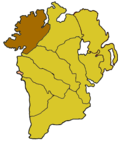
|
www.raphoediocese.ie |
Ecclesiastical Province of Cashel-Emly
| Archdiocese / Diocese | cathedral | Location of the diocese on the island |
website | |
|---|---|---|---|---|
|
Archbishopric of Cashel and Emly Archbishop of Cashel and Emly |
Cathedral of the Assumption of the Blessed Virgin Mary , Thurles |

|
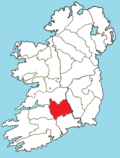
|
www.cashel-emly.ie |
|
Diocese of Cloyne Bishop of Cloyne |
St. Colman's Cathedral , Cobh |

|
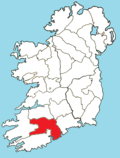
|
www.cloynediocese.ie |
|
Diocese of Cork and Ross Bishop of Cork and Ross |
Cathedral of St Mary and St Anne, Cork |

|

|
www.corkandross.org |
|
Bishopric of Kerry Bishop of Kerry |
St Mary's Cathedral , Killarney |

|

|
www.dioceseofkerry.ie |
|
Diocese of Killaloe Bishop of Killaloe |
Cathedral of Saints Peter and Paul, Ennis |

|
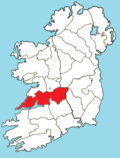
|
www.killaloediocese.ie |
|
Bishopric of Limerick Bishop of Limerick |
Cathedral St. John the Baptist , Limerick |

|

|
www.limerickdiocese.org |
|
Bishopric of Waterford and Lismore Bishop of Waterford and Lismore |
Cathedral of the Most Holy Trinity, Waterford |

|

|
www.waterfordlismore.ie |
Ecclesiastical Province of Dublin
| Archdiocese / Diocese | cathedral | Location of the diocese in the ecclesiastical province |
website | |
|---|---|---|---|---|
|
Archbishopric of Dublin Archbishop of Dublin |
St. Mary's Procathedral , Dublin |

|
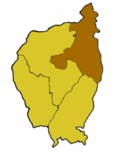
|
dublindiocese.ie/ |
|
Diocese of Ferns Bishop of Ferns |
St. Aidan's Cathedral , Enniscorthy |

|
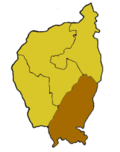
|
www.ferns.ie/ |
|
Bishopric of Kildare and Leighlin Bishop of Kildare and Leighlin |
Cathedral of the Assumption, Carlow |

|

|
kandle.ie |
|
Bishopric of Ossory Bishop of Ossory |
Cathedral of the Assumption of the Blessed Virgin Mary , Kilkenny |

|

|
www.ossory.ie |
Church province of Tuam
| Archdiocese / Diocese | cathedral | Location of the diocese in the ecclesiastical province |
website | |
|---|---|---|---|---|
|
Archbishopric of Tuam Archbishop of Tuam |
Cathedral of the Assumption of the Blessed Virgin Mary , Tuam |

|

|
tuamarchdiocese.org |
|
Diocese of Achonry Bishop of Achonry |
Cathedral of the Annunciation of the Blessed Virgin Mary and St Nathy, Ballaghaderreen |

|

|
www.achonrydiocese.org |
|
Diocese of Clonfert Bishop of Clonfert |
St Brendan's Cathedral, Loughrea |

|
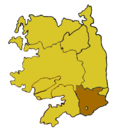
|
www.clonfertdiocese.ie |
|
Diocese of Elphin Bishop of Elphin |
Cathedral of the Immaculate Conception, Sligo |

|

|
www.elphindiocese.ie |
|
Bishopric of Galway and Kilmacduagh Bishop of Galway and Kilmacduagh |
Cathedral of Our Lady Assumed into Heaven and St. Nicholas , Galway |

|
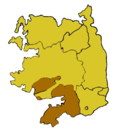
|
www.galwaydiocese.ie |
|
Diocese of Killala Bishop of Killala |
St. Muredach's Cathedral, Ballina |

|
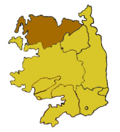
|
www.killaladiocese.org |
Lists of bishops
- List of Archbishops of Armagh
- List of Archbishops of Dublin
- List of Archbishops of Tuam
- List of the Bishops of Clogher
- List of the bishops of Clonfert
- List of the bishops of Raphoe
- List of the Bishops of Waterford and Lismore
The central body of the Irish bishops is the Irish Bishops' Conference .
See also
literature
- Non-fiction
- Contemporary Catholicism in Ireland: A Critical Appraisal (Paperback), Ed. John Littleton, Eamon Maher, Columbia Press, 2008, ISBN 1-85607616-4
- Eamonn Conway: Good news and bad news. The Church in Ireland after a difficult decade. In: Herder correspondence. Monthly books for society and religion . ISSN 0018-0645 , 58, 2004, No. 1, pp. 11-16.
- Brian Girvin: Church, State, and Society in Ireland since 1960. In: Éire-Ireland - Volume 43: 1 & 2, Earrach / Samhradh / Spring / Summer 2008, pp. 74–98.
- Tom Inglis: Moral Monopoly: The Rise and Fall of the Catholic Church in Modern Ireland. Univ. College Dublin Press, 2nd Revised edition, 1998, ISBN 1-90062112-6 .
- Moira J. Maguire: The changing face of catholic Ireland: Conservatism and Liberalism in the Ann Lovett and Kerry Babies Scandal. In: Feminist Studies ISSN 0046-3663 , 27, 2001, No. 2, pp. 335-359
- John Boyne : The Story of Solitude . Novel. Translated by Sonja Finck . Piper, Munich 2015 ISBN 3492060145
Web links
- Homepage of the Irish Bishops' Conference
- History of the Catholic Church 1 , catholicity.elcore.net
- History of the Catholic Church 2 , catholicity.elcore.net
- History of the Catholic Church 3 , catholicity.elcore.net
Individual evidence
- ↑ a b fr.de: Francis encounters an angry people
- ↑ a b c d Ralf Borchard: Report on decades of abuse published. Shattering from Ireland's “Houses of Horror” ( Memento from May 23, 2009 in the Internet Archive ). In: Tagesschau, May 20, 2009.
- ↑ Martin Alioth : Scandal in Ireland's Church. Beaten, humiliated, raped . In Spiegel Online, May 20, 2009. Investigation report. Thousands of children abused in Church homes in Ireland . In Spiegel Online , May 20, 2009 Brady calls for change of culture . In: RTÉ News , October 20, 2007. Patsy McGarry: Primate urged Cardinal Connell to drop action ( Memento of the original from November 17, 2010 in the Internet Archive ) Info: The archive link was inserted automatically and has not yet been checked. Please check the original and archive link according to the instructions and then remove this notice. . In: The Irish Times , February 12, 2008.
- ↑ Abuse scandal. Irish bishops offer resignation on Christmas Eve . In: Spiegel Online , December 25, 2009.
- ↑ Global Index of Religions and Atheism ( Memento of the original from October 16, 2012 in the Internet Archive ) Info: The archive link was automatically inserted and not yet checked. Please check the original and archive link according to the instructions and then remove this notice. . WIN-Gallup International, 2012, press release. 2012 survey
- ↑ FAZ.net / Jörg Bremer : When Catholic priests become fathers
- ↑ Number of prospective priests at record low. Retrieved April 14, 2019 .
- ↑ The protagonist is good friends with a child abusive pastor who is on the same hierarchical level. For decades he ignored all signs of what he was doing, so that the perpetrator even became active in the friend's family. The hierarchy covers the perpetrator, only at the end he is removed from office. The protagonist ponders for a long time why he behaved this way; only at the end of the novel does he admit to himself that his behavior was also guilty and that boys suffered a lot as a result, up to and including suicide. He had suppressed all references to the crimes, shifted them into the subconscious, because he himself loved the priestly profession. In addition, the novel vividly describes how in the years after 2009, as a result of the discoveries, a strong hatred of the Catholic Church in general developed in Ireland.

